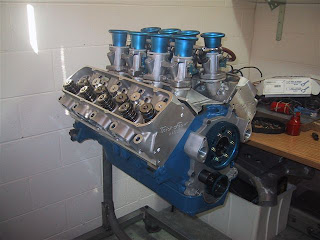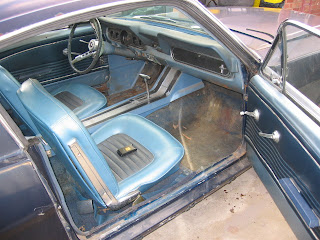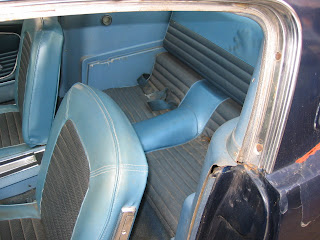For the last few years while I haven't had a car, I've been slowly putting together the pieces for a new motor. This may seem a little "cart before the horse" but I had my reasons as follows...... When child number 3 came along the ute simply wasn't appropriate any more. The ute itself was fine, it's just that we couldn't all fit in it! As it had so many "go fast" goodies installed, I ripped all the running gear out and sold the shell. Sadly, this left me with just a 351C sitting there in the garage and by this time it was a bit "tired" too. I satisfied my need to tinker by stripping it down and cleaning up the EFI system. The 351C always went well off the mark, bogged down a little in mid-range, but then came on strong again above about 4500RPM. "Bogged down" is a relative thing though - it still went hard, just a little less so in mid-range. It seemed obvious to me that eight 50mm throttle bodies would cause this as the intake runner velocity would be slow until higher RPM's in a 6litre V8 (at wide open throttle - WOT). The EFI injector spray pattern masked the problem with good fuel atomisation off-the-line, but the mid-range at WOT exposed things. Here is the EFI setup I used.....
I made the manifold from 5mm plate and hand-formed the bends. Then I made a steel jig to minimise warpage and TIG welded the lot together. I had to use thick(ish) gaskets between the head and manifold to remove vacuum leaks but other than that it worked great. The design allowed the injectors to have a straight shot down the 351C intake runner. You can see the cold-air box sitting on the table behind. It was nice and low profile to keep everything under the bonnet but gave plenty of room for airflow to the trumpets.
In order to address my suspected "low velocity in the intake runner" problem, the only solutions I saw were either to drop back the number of throttle bodies (eg, use two of the "duel webber" throttle bodies) or use the existing induction on a much bigger engine. As I already had the "quad webber" EFI induction system and I had the Autronic EFI system that can manage all 8 cylinders individually - I decided on a Ford big-block. I chose to go with the newer "385 series" 429/460 cubic inch over the "FE" 427/428 because the parts I would need are cheaper and more easily available in Australia. The first bits I got were the heads. I decided on TrickFlow A460's as they flow really well and would compliment my "quad-webber" induction. Here are the heads as landed in the box from Summit Racing.....
They have huge valves, good springs (for a roller cam), titanium retainers and the intake and exhaust ports are nicely raised to avoid the typical Ford problems of tight bends in the runners.
See above, there is a nice straight shot at the back of the intake (and even better for the exhaust) valves - no nasty bends here!
All I need to do is build a "transition port plate" to mate the outlet face of the throttle bodies to the intake face of the heads. The technical folk at TrickFlow very nicely sent me the intake-face spec's for the A460 head so I can use these as input to a CAD program. The bottom of the throttle bodies are a simple webber pattern. By "morphing" in a CAD program from one port shape to the other (from the circular outlet of the throttle-body to the rectangular intake on the heads) within a 20 or 25mm block of aluminium, I should be able to build the correct configuration file to feed into a CNC milling machine. I soon discovered that while this is nice in theory - I simply cannot find a CAD/CAM package right now that can "easily" do this for me. I've tried lots of sample packages found on the internet - but none make this an easy task. If anyone out there knows of a package that can do this then please let me know. As I only need to create one "drawing", I don't want to have to pay for a whole package.... My backup is to simply hand-form each plate with my drills, die grinder, thread-tappers, etc - but this is messy, time consuming and both plates will be slightly different no matter how careful I am. CNC produced plates would be exactly the same and have a better surface finish.
Compared to the 351C manifold I welded together - which had the throttle-bodies sitting up above the motor and facing upwards, I intend to have the big-block induction runners come straight out perpendicular to the intake face on the heads and "cross over" each other. This means each runner hardly has a bend and allows the whole system to be the lowest profile possible (for fitting under the standard bonnet). I'll be building a single or duel cold-air intake plenum(s) that will sit just above each rocker cover. The plenum(s) will be fed cold and filtered air from behind each headlight. The whole package needs to fit under a 65/66 Shelby style bonnet - that being the fibreglass bonnet skin and scoop grafted to the standard metal bonnet frame.
Here are some photo's that compare the heights of the intake systems when crossing or not-crossing the intake runners. A lot of vertical space is saved by crossing the runners! 
Note that the above "crossed" setup is yet to include the "transition port plate" and there are no intake extensions enabling the trumpets to cross.
My final system will have the trumpets on each bank crossing each other by 50mm or so, so opposing trumpets don't steal air from each other - as would happen in the above photo.
Lastly, as the 50mm ports on the throttle bodies are quite a bit smaller than the intake port on the heads, there is potential for the intake charge to slow-down and "tumble" - if transitioning too quickly from the circular throttle-body to rectangular intake port. To avoid this I am going to insert "inlet tongues" to fill the lower portion (just the first half) of the A460 intake ports. The final design will have the intake charge following the roof contour of the intake runner in the head - for maximum speed and minimal turns.
Once completed, this induction system should be the equal of any going around.







